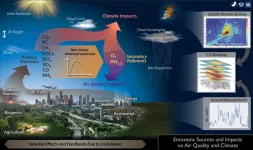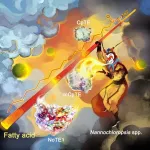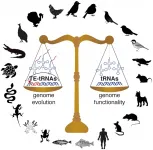Diabetes drug shows potential in fighting cancer
Phenformin may have structural and therapeutic advantages over its sister compound metformin for future cancer treatment
2021-04-14
(Press-News.org) BOSTON - The anti-diabetic drug phenformin may prompt stronger cancer-fighting activities than its sister compound metformin, a finding that could have major implications for current and future clinical trials investigating both agents for their anti-cancer potential, according to researchers at Massachusetts General Hospital (MGH). In a review article in Trends in Cancer, the team presented evidence that immunotherapies such as immune checkpoint inhibitors (which enable T cells to attack and kill cancer cells) in combination with phenformin may also be a promising way to repurpose this diabetic drug as an anti-cancer agent.
Metformin was approved by the U.S. Food and Drug Administration in 1995 and has since become the most prescribed drug for diabetes in the United States. Phenformin was first prescribed for type 2 diabetes in the 1950s but was withdrawn from use in the late 1970s due to the risk of lactic acidosis, a potentially dangerous condition caused by excess buildup of lactic acid in the blood, which can disrupt the body's pH balance. Metformin and phenformin are members of a class of anti-diabetic drugs known as biguanides that originated from compounds in the French lilac, a plant known for its hypoglycemic properties since medieval times. Preclinical studies over the past ten years by MGH and others have demonstrated that both forms of biguanides possess anti-tumor activity, spurring efforts to repurpose them for cancer prevention and treatment.
"While the outcomes of various clinical studies of metformin in cancer patients have been underwhelming, research from our laboratory and others suggests that phenformin may have greater potential, particularly in combination with immunotherapies," says Bin Zheng, PhD, the study's senior author and an investigator in the Cutaneous Biology Research Center at MGH. "We have found, for example, that phenformin, but not metformin, enhances the efficacy of BRAF inhibitors in suppressing the proliferation of BRAF-mutant melanoma cells and BRAF-driven tumor growth in animal models." BRAF mutations are changes in cellular DNA that are found in about half of all melanomas.
After years of preclinical research, MGH has partnered with Memorial Sloan Kettering Cancer Center to launch a phase 1 clinical trial evaluating phenformin with a combination of inhibitors (dabrafenib/trametinib) in patients with BRAF-mutated melanoma. "If the safety of phenformin is confirmed in this trial, combinations of phenformin with targeted immunotherapies such as anti-PD-1 (programmed cell death 1 antibodies, which stimulate anti-tumor immunity) could be explored for patients with various types of solid tumors," says Zheng. Another retrospective study has shown improved clinical outcomes in patients with non-small-cell lung cancer who received immune checkpoint inhibitors in combination with metformin, compared to the inhibitors alone.
With respect to mechanisms of action governing the anti-tumor activity of biguanides, the MGH team noted that gut microbiota - the trillions of cells, including bacteria, viruses and fungi, that reside in the gut and are vital to normal health - could play a key role. They suggested that biguanides may affect the anti-tumor efficacy of therapies by modulating gut microbiota, in the same way metformin may lower blood glucose levels in diabetes patients in part by interacting with the microbiome.
"Scientists have shown a tremendous interest in biguanides as potential anti-cancer agents, and we believe our work will help the field to focus on the most promising ways forward, particularly phenformin," says Zheng. "Phenformin demonstrates more metabolic and pharmacologic potential than metformin, and its toxicity, which might be a problem for certain people with diabetes, is actually lower than some current chemotherapies."
INFORMATION:
Zheng is an associate professor of dermatology at Harvard Medical School (HMS). Lead author Hongyun Zhao, PhD, is a postdoctoral research fellow at MGH and HMS. Co-author Kenneth Swanson, PhD, is an instructor in Neurology at Beth Israel Deaconess Medical Center.
The study was supported by the National Institutes of Health, the Melanoma Research Alliance and Worldwide Cancer Research.
About the Massachusetts General Hospital
Massachusetts General Hospital, founded in 1811, is the original and largest teaching hospital of Harvard Medical School. The Mass General Research Institute conducts the largest hospital-based research program in the nation, with annual research operations of more than $1 billion and comprises more than 9,500 researchers working across more than 30 institutes, centers and departments. In August 2020, Mass General was named #6 in the U.S. News & World Report list of "America's Best Hospitals."
ELSE PRESS RELEASES FROM THIS DATE:
2021-04-14
One consequence of the coronavirus pandemic has been global restrictions on mobility. This, in turn, has had an effect on pollution levels in the atmosphere. Researchers from across the world are using this unique opportunity to take measurements, collect data, and publish studies. An international team led by Forschungszentrum Jülich's Institute of Climate and Energy Research - Troposphere has now published a comprehensive review providing an overview of results up to September 2020. The study also has its own dedicated website, where additional measurement data can be added to supplement and refine existing research results. At the same time, this collection of data allows scientifically substantiated predictions to be made about the ...
2021-04-14
By combining the 'chassis' of an oil-producing microalgae with genes from a Cuphea plant, scientists from the Single-Cell Center, Qingdao Institute of BioEnergy and Bioprocess Technology (QIBEBT) of the Chinese Academy of Sciences (CAS), can turn the algae into a microbial cell factory that can produce various oils with different properties.
The study was published in Metabolic Engineering on April 3.
Oils are composed of fatty acids, and fatty acids are composed in part of chains of carbon atoms. The length of these carbon chains can impact the physical properties of the fatty acid and thus the ...
2021-04-14
While people may expect suicide rates to rise during a worldwide crisis such as the COVID-19 pandemic, a University of Michigan study suggests the onset of the pandemic and state of emergency executive orders likely did not increase suicide-related behavior in the early months of the outbreak.
The report, led by U-M researchers Rachel Bergmans and Peter Larson, found that emergency room visits related to suicide attempt and self-harm decreased by 40% during the first eight months of Michigan's lockdown. Their results are published in the Journal of Epidemiology and Community Health.
The study compared emergency room reports of suicide attempt and intentional self-harm at a hospital in Michigan's Washtenaw County during the first 8 months of the ...
2021-04-14
The COVID-19 pandemic has cast a harsh light on the urgent need for quick and easy techniques to sanitize and disinfect everyday high-touch objects such as doorknobs, pens, pencils, and personal protective gear worn to keep infections from spreading. Now scientists at the U.S. Department of Energy's (DOE) Princeton Plasma Physics Laboratory and the New Jersey Institute of Technology (NJIT) have demonstrated the first flexible, hand-held, device based on low-temperature plasma -- a gas that consists of atoms, molecules, and free-floating electrons ...
2021-04-14
Birds have been shaped by evolution in many ways that have made them distinct from their vertebrate cousins. Over millions of years of evolution, our feathered friends have taken to the skies, accompanied by unique changes to their skeleton, musculature, respiration, and even reproductive systems. Recent genomic analyses have identified another unique aspect of the avian lineage: streamlined genomes. Although bird genomes contain roughly the same number of protein-coding genes as other vertebrates, their genomes are smaller, containing less noncoding DNA. Scientists are still exploring the potential consequences of this genome reduction on bird biology. In a new ...
2021-04-14
UPTON, NY--Scientists at the U.S. Department of Energy's (DOE) Brookhaven National Laboratory and the University of Illinois Urbana-Champaign (UIUC) have developed a new mathematical model for predicting how COVID-19 spreads. This model not only accounts for individuals' varying biological susceptibility to infection but also their levels of social activity, which naturally change over time. Using their model, the team showed that a temporary state of collective immunity--what they coined "transient collective immunity"--emerged during early, fast-paced stages of the epidemic. However, subsequent "waves," ...
2021-04-14
An alloy is typically a metal that has a few per cent of at least one other element added. Some aluminium alloys have a seemingly strange property.
"We've known that aluminium alloys can become stronger by being stored at room temperature - that's not new information," says Adrian Lervik, a physicist at the Norwegian University of Science and Technology (NTNU).
The German metallurgist Alfred Wilm discovered this property way back in 1906. But why does it happen? So far the phenomenon has been poorly understood, but now Lervik and his colleagues from NTNU and SINTEF, the largest independent research institute in Scandinavia, have tackled that question.
Lervik recently completed his doctorate at NTNU's Department of Physics. His work explains an important part of this ...
2021-04-14
Patients who have preexisting respiratory conditions such as asthma or chronic obstructive pulmonary disease (COPD) and live in areas with high levels of air pollution have a greater chance of hospitalization if they contract COVID-19, says a University of Cincinnati researcher.
Angelico Mendy, MD, PhD, assistant professor of environmental and public health sciences, at the UC College of Medicine, looked at the health outcomes and backgrounds of 1,128 COVID-19 patients at UC Health, the UC-affiliated health care system in Greater Cincinnati.
Mendy led a team of researchers in an individual-level study which used a statistical model to evaluate the association between long-term exposure to particulate matter less or equal to 2.5 micrometers -- it refers to a mixture of tiny particles and ...
2021-04-14
Researchers have found a long-sought enzyme that prevents cancer by enabling the breakdown of proteins that drive cell growth, and that causes cancer when disabled.
Publishing online in Nature on April 14, the new study revolves around the ability of each human cell to divide in two, with this process repeating itself until a single cell (the fertilized egg) becomes a body with trillions of cells. For each division, a cell must follow certain steps, most of which are promoted by proteins called cyclins.
Led by researchers at NYU Grossman School of Medicine, the work revealed that an enzyme called AMBRA1 labels a key class of cyclins for destruction by cellular machines that break down proteins. The work finds that the enzyme's control of cyclins is essential ...
2021-04-14
ITHACA, N.Y. - Eurasian Blackcaps are spunky and widespread warblers that breed across much of Europe. Many of them migrate south to the Mediterranean region and Africa after the breeding season. But thanks to a changing climate and an abundance of food resources offered by people across the United Kingdom and Ireland, some populations of Blackcaps have recently been heading north for the winter, spending the colder months in backyard gardens of the British Isles.
New research published this week in Global Change Biology shows some of the ways that bird feeders, fruit-bearing plants, and a warming world are changing both the movements and the physiology of the Blackcaps that spend the winter in Great Britain and Ireland.
"Many migratory birds are ...
LAST 30 PRESS RELEASES:
[Press-News.org] Diabetes drug shows potential in fighting cancer
Phenformin may have structural and therapeutic advantages over its sister compound metformin for future cancer treatment





